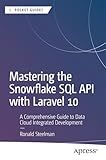Best Laravel Foreign Key Seeding Tools to Buy in October 2025
In Laravel, seeding foreign keys can be done by using the relationships between models in the seeder class.
For example, if you have a Post model that belongs to a User model through a foreign key user_id, you can seed the Post model with the corresponding User by creating a factory for each model and using the create method in the seeder class.
In the seeder class, you can use the factory helper function and the create method to create instances of models with foreign key relationships. For example, if you want to seed a Post model with a User, you can do so by calling the factory function for the Post model and using the create method to assign a User to the post.
Here is an example of how you can seed a Post model with a User in the seeder class:
use App\Models\User; use App\Models\Post;
$user = User::factory()->create();
Post::factory()->create([ 'user_id' => $user->id ]);
By following this approach, you can easily seed foreign keys in Laravel using model factories in the seeder classes.
How to generate foreign key constraints in Laravel migrations?
To generate foreign key constraints in Laravel migrations, you can use the foreign() method provided by the Schema builder. Here is an example of how you can generate a foreign key constraint in a Laravel migration:
public function up() { Schema::create('posts', function (Blueprint $table) { $table->id(); $table->unsignedBigInteger('user_id'); $table->foreign('user_id')->references('id')->on('users')->onDelete('cascade'); $table->string('title'); $table->timestamps(); }); }
In this example, we are creating a posts table with a foreign key constraint on the user_id column that references the id column in the users table. The onDelete('cascade') method specifies that if a user is deleted, all related posts will also be deleted.
You can modify this code to create foreign key constraints for any other relationships in your database. Remember to run php artisan migrate after creating your migration to apply the changes to your database.
What is the difference between foreign keys and primary keys in Laravel seeding?
In Laravel seeding, foreign keys and primary keys serve different purposes:
- Primary keys:
- Primary keys are used to uniquely identify each record in a database table.
- In Laravel seeding, primary keys are typically defined as the 'id' column in a table using the $table->id() method in the migration file.
- Primary keys are essential for establishing relationships between tables in a database.
- Foreign keys:
- Foreign keys are used to establish relationships between tables in a database.
- In Laravel seeding, foreign keys are defined using the $table->foreign('column_name')->references('id')->on('related_table') method in the migration file.
- Foreign keys typically refer to the primary key of another table to create a relationship between the two tables.
- Foreign keys are used to maintain referential integrity in a database, ensuring that data in related tables remains consistent and accurate.
In summary, primary keys are used for unique identification of records, while foreign keys are used to establish relationships between tables in a database.
How to create custom foreign key constraints in Laravel migrations?
To create custom foreign key constraints in Laravel migrations, you can use the Schema facade's table method and the foreign method to define your custom foreign key constraints. Here's an example of how you can create a custom foreign key constraint in a Laravel migration:
- First, create a new migration file using the php artisan make:migration command:
php artisan make:migration create_foreign_key_constraint
- In the generated migration file, use the Schema facade to define your custom foreign key constraint. For example, if you want to add a foreign key constraint from the posts table's user_id column to the users table's id column:
use Illuminate\Database\Schema\Blueprint; use Illuminate\Support\Facades\Schema;
class CreateForeignKeyConstraint extends Migration { public function up() { Schema::table('posts', function (Blueprint $table) { // Add a foreign key constraint from the 'user_id' column in the 'posts' table // to the 'id' column in the 'users' table $table->foreign('user_id')->references('id')->on('users')->onDelete('cascade'); }); }
public function down()
{
Schema::table('posts', function (Blueprint $table) {
// Drop the foreign key constraint when rolling back the migration
$table->dropForeign(\['user\_id'\]);
});
}
}
- Finally, run the migration using the migrate command to apply the custom foreign key constraint to your database:
php artisan migrate
After running the migration, the custom foreign key constraint will be added to your database table schema. You can customize the foreign key constraints by specifying additional options such as onDelete or onUpdate actions.
How to set up foreign key relationships in Laravel models?
Setting up foreign key relationships in Laravel models is easy and involves the use of Eloquent, Laravel's object-relational mapping (ORM) system.
Here's a step-by-step guide on how to set up foreign key relationships in Laravel models:
- Define the relationships in your Eloquent model classes. For example, if you have a Post model that belongs to a User, you would define the relationship in your Post model like this:
class Post extends Model { public function user() { return $this->belongsTo(User::class); } }
- Define the inverse relationship in your related model. In this example, define the inverse relationship in your User model like this:
class User extends Model { public function posts() { return $this->hasMany(Post::class); } }
- When creating migrations for your models, make sure to add foreign key constraints to define the relationship between tables. For example, in your posts table migration, you would add a foreign key constraint to link the user_id column to the id column in the users table:
Schema::create('posts', function (Blueprint $table) { $table->id(); $table->unsignedBigInteger('user_id'); $table->foreign('user_id')->references('id')->on('users'); $table->timestamps(); });
- Make sure to define the foreign key column name in your Eloquent model if it does not follow Laravel conventions. For example, if your foreign key column is named author_id instead of user_id, you can specify the column name in the belongsTo relationship method:
public function user() { return $this->belongsTo(User::class, 'author_id'); }
- With these relationships set up in your models, you can now easily access related data through Eloquent's dynamic properties. For example, you can retrieve a post's author like this:
$post = Post::find(1); $author = $post->user;
By following these steps, you can easily set up foreign key relationships in your Laravel models and leverage the power of Eloquent to manage your database relationships effectively.



